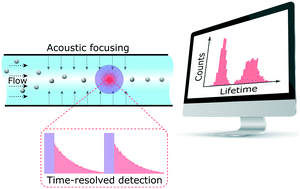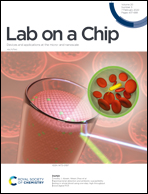Time-resolved microfluidic flow cytometer for decoding luminescence lifetimes in the microsecond region†
Abstract
Time-resolved luminescence detection using long-lived probes with lifetimes in the microsecond region have shown great potential in ultrasensitive and multiplexed bioanalysis. In flow cytometry, however, the long lifetime poses a significant challenge to measure wherein the detection window is often too short to determine the decay characteristics. Here we report a time-resolved microfluidic flow cytometer (tr-mFCM) incorporating an acoustic-focusing chip, which allows slowing down of the flow while providing the same detection conditions for every target, achieving accurate lifetime measurement free of autofluorescence interference. Through configuration of the flow velocity and detection aperture with respect to the time-gating sequence, a multi-cycle luminescence decay profile is captured for every event under maximum excitation and detection efficiency. A custom fitting algorithm is then developed to resolve europium-stained polymer microspheres as well as leukemia cells against abundant fluorescent particles, achieving counting efficiency approaching 100% and lifetime CVs (coefficient of variation) around 2–6%. We further demonstrate lifetime-multiplexed detection of prostate and bladder cancer cells stained with different europium probes. Our acoustic-focusing tr-mFCM offers a practical technique for rapid screening of biofluidic samples containing multiple cell types, especially in resource-limited environments such as regional and/or underdeveloped areas as well as for point-of-care applications.



 Please wait while we load your content...
Please wait while we load your content...